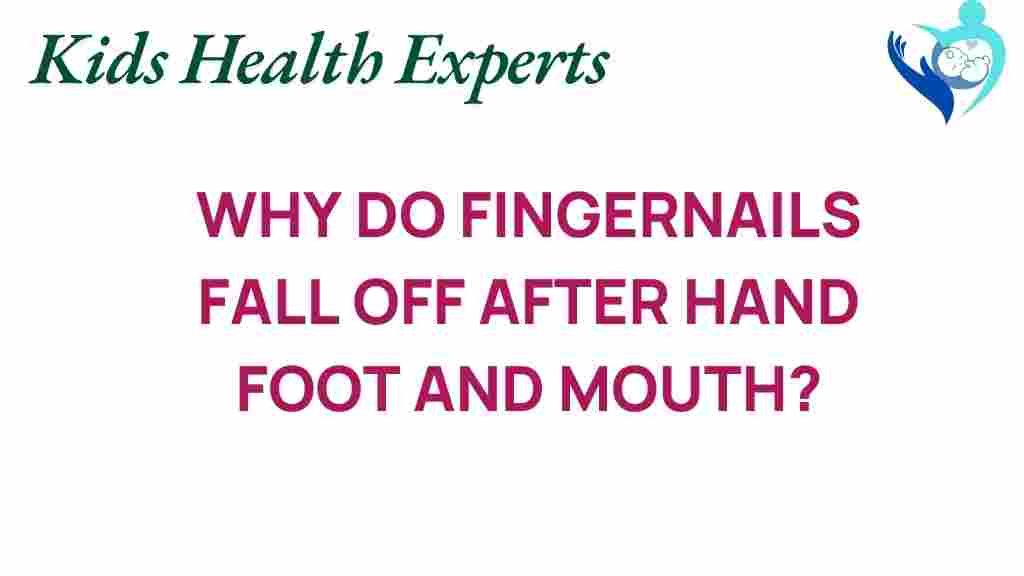The Surprising Link Between Hand, Foot, and Mouth Disease and Nail Loss
Hand, foot, and mouth disease (HFMD) is a common viral infection that primarily affects infants and young children. While the symptoms are often mild and self-limiting, recent observations have revealed a surprising connection between HFMD and nail loss. In this article, we will delve into the symptoms of hand, foot, and mouth disease, explore the potential mechanisms behind nail loss, and discuss recovery processes, particularly in the context of pediatric health.
Understanding Hand, Foot, and Mouth Disease
Hand, foot, and mouth disease is caused by several viruses, most commonly the coxsackievirus. The condition is characterized by a range of symptoms that can impact a child’s health.
- Fever: Often the first sign, a mild fever may appear.
- Rash: A red rash can develop on the palms of the hands and soles of the feet.
- Oral sores: Painful sores may develop in the mouth, making eating and drinking difficult.
- Loss of appetite: Due to oral discomfort, children may refuse to eat.
Symptoms of Nail Loss Associated with HFMD
While hand, foot, and mouth disease is primarily linked to symptoms affecting the mouth and extremities, some children may experience nail loss as a secondary effect. This phenomenon can be surprising to parents and caregivers.
Nail loss can manifest as:
- Partial or total nail shedding: Nails may loosen and fall off after the infection has resolved.
- Nail discoloration: Nails may appear yellowed or discolored prior to shedding.
- Pain or tenderness: The area around the nail bed may be sensitive.
How Hand, Foot, and Mouth Disease Leads to Nail Loss
The exact mechanism behind the link between hand, foot, and mouth disease and nail loss is not entirely understood. However, several theories have been proposed:
- Viral invasion: The coxsackievirus can invade the nail matrix, causing inflammation and subsequent nail loss.
- Immune response: The body’s immune response to the viral infection may inadvertently target nail cells, leading to shedding.
- Secondary infections: Bacterial infections following HFMD can also compromise nail health.
Recovery from Hand, Foot, and Mouth Disease
Recovery from hand, foot, and mouth disease is usually straightforward, with most children recovering within 7 to 10 days. Here are some steps to support recovery:
- Hydration: Ensure the child stays well-hydrated, especially if they have oral sores.
- Soft foods: Offer soft, bland foods that are easy to swallow.
- Fever management: Use fever-reducing medications as needed, following pediatric guidelines.
- Rest: Encourage plenty of rest to aid the body’s recovery process.
What to Expect After Recovery
After recovering from hand, foot, and mouth disease, parents may notice changes in their child’s nails. Here’s what to expect:
- Timeframe for nail regrowth: Nails typically begin to regrow within a few weeks, though this may vary.
- Monitoring for infections: Keep an eye on the nail beds for signs of infection or inflammation.
- Consulting a dermatologist: If nail loss persists or worsens, seek advice from a dermatologist.
Pediatric Health Considerations
Hand, foot, and mouth disease is more prevalent in young children, particularly those under five years of age. Understanding the symptoms and implications of infections is crucial for pediatric health.
Here are some important considerations:
- Preventive measures: Good hygiene practices, such as frequent handwashing, can help prevent the spread of HFMD.
- Awareness of symptoms: Parents should be vigilant for early symptoms to ensure timely management.
- Follow-up care: Regular pediatric check-ups are essential to monitor a child’s overall health and development.
Dealing with Nail Loss
Nail loss, while often temporary, can be distressing for both children and parents. Here are some tips for managing this issue:
- Keep nails clean: Clean the nail beds gently to prevent infections.
- Moisturize: Use gentle moisturizers to keep the skin around the nails hydrated.
- Protective coverings: Consider using protective bandages if the nail area is sensitive.
- Consult a professional: If persistent issues arise, refer to a healthcare professional for advice.
When to Seek Medical Attention
While most cases of hand, foot, and mouth disease resolve without complications, there are instances when medical attention is necessary:
- Severe symptoms: If the child exhibits a high fever or severe pain.
- Signs of dehydration: If the child is unable to drink fluids or shows signs of dehydration.
- Persistent nail loss: If nails do not begin to regrow within a reasonable timeframe.
Conclusion
The link between hand, foot, and mouth disease and nail loss is an intriguing aspect of pediatric health that requires further investigation. While HFMD is typically mild, understanding its potential effects, including nail loss, helps parents manage their child’s recovery effectively. By monitoring symptoms and seeking appropriate care, families can navigate this viral infection with confidence.
For more information on pediatric infections and dermatology, consider visiting this resource. Additionally, if you’re looking for more articles on children’s health, feel free to check out this link for a wealth of information.
This article is in the category Conditions and created by KidsHealthExperts Team
